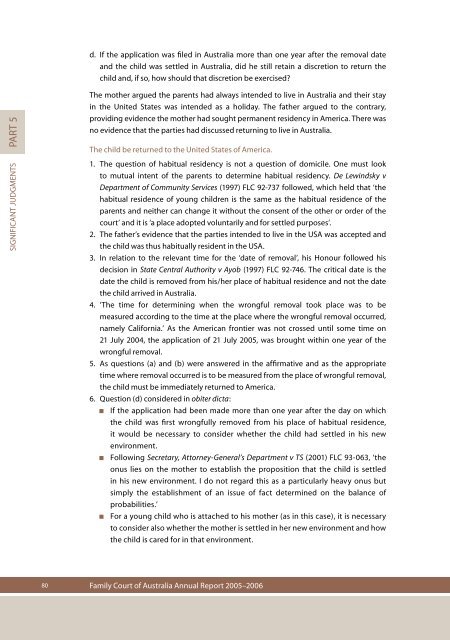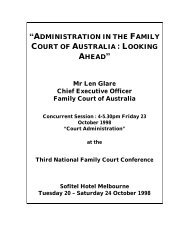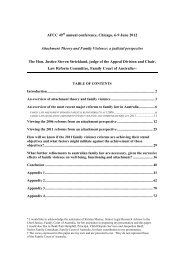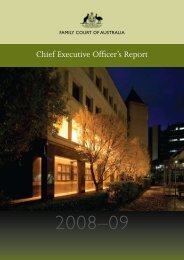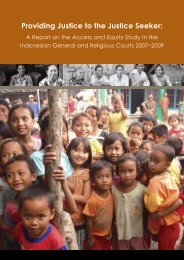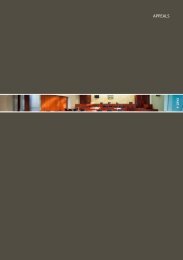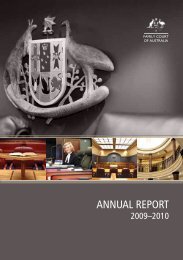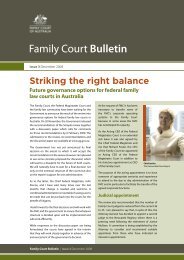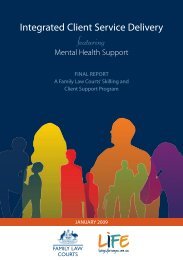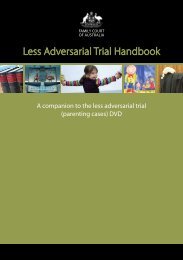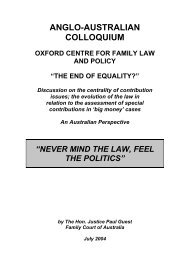View a full copy of this report (PDF Size - 3.69 MB) - Family Court of ...
View a full copy of this report (PDF Size - 3.69 MB) - Family Court of ...
View a full copy of this report (PDF Size - 3.69 MB) - Family Court of ...
You also want an ePaper? Increase the reach of your titles
YUMPU automatically turns print PDFs into web optimized ePapers that Google loves.
d. If the application was filed in Australia more than one year after the removal date<br />
and the child was settled in Australia, did he still retain a discretion to return the<br />
child and, if so, how should that discretion be exercised?<br />
SIGNIFICANT JUDGMENTS Part 5<br />
The mother argued the parents had always intended to live in Australia and their stay<br />
in the United States was intended as a holiday. The father argued to the contrary,<br />
providing evidence the mother had sought permanent residency in America. There was<br />
no evidence that the parties had discussed returning to live in Australia.<br />
The child be returned to the United States <strong>of</strong> America.<br />
1. The question <strong>of</strong> habitual residency is not a question <strong>of</strong> domicile. One must look<br />
to mutual intent <strong>of</strong> the parents to determine habitual residency. De Lewindsky v<br />
Department <strong>of</strong> Community Services (1997) FLC 92-737 followed, which held that ‘the<br />
habitual residence <strong>of</strong> young children is the same as the habitual residence <strong>of</strong> the<br />
parents and neither can change it without the consent <strong>of</strong> the other or order <strong>of</strong> the<br />
court’ and it is ‘a place adopted voluntarily and for settled purposes’.<br />
2. The father’s evidence that the parties intended to live in the USA was accepted and<br />
the child was thus habitually resident in the USA.<br />
3. In relation to the relevant time for the ‘date <strong>of</strong> removal’, his Honour followed his<br />
decision in State Central Authority v Ayob (1997) FLC 92-746. The critical date is the<br />
date the child is removed from his/her place <strong>of</strong> habitual residence and not the date<br />
the child arrived in Australia.<br />
4. ‘The time for determining when the wrongful removal took place was to be<br />
measured according to the time at the place where the wrongful removal occurred,<br />
namely California.’ As the American frontier was not crossed until some time on<br />
21 July 2004, the application <strong>of</strong> 21 July 2005, was brought within one year <strong>of</strong> the<br />
wrongful removal.<br />
5. As questions (a) and (b) were answered in the affirmative and as the appropriate<br />
time where removal occurred is to be measured from the place <strong>of</strong> wrongful removal,<br />
the child must be immediately returned to America.<br />
6. Question (d) considered in obiter dicta:<br />
If the application had been made more than one year after the day on which<br />
the child was first wrong<strong>full</strong>y removed from his place <strong>of</strong> habitual residence,<br />
it would be necessary to consider whether the child had settled in his new<br />
environment.<br />
Following Secretary, Attorney-General’s Department v TS (2001) FLC 93-063, ‘the<br />
onus lies on the mother to establish the proposition that the child is settled<br />
in his new environment. I do not regard <strong>this</strong> as a particularly heavy onus but<br />
simply the establishment <strong>of</strong> an issue <strong>of</strong> fact determined on the balance <strong>of</strong><br />
probabilities.’<br />
For a young child who is attached to his mother (as in <strong>this</strong> case), it is necessary<br />
to consider also whether the mother is settled in her new environment and how<br />
the child is cared for in that environment.<br />
80<br />
<strong>Family</strong> <strong>Court</strong> <strong>of</strong> Australia Annual Report 2005–2006


